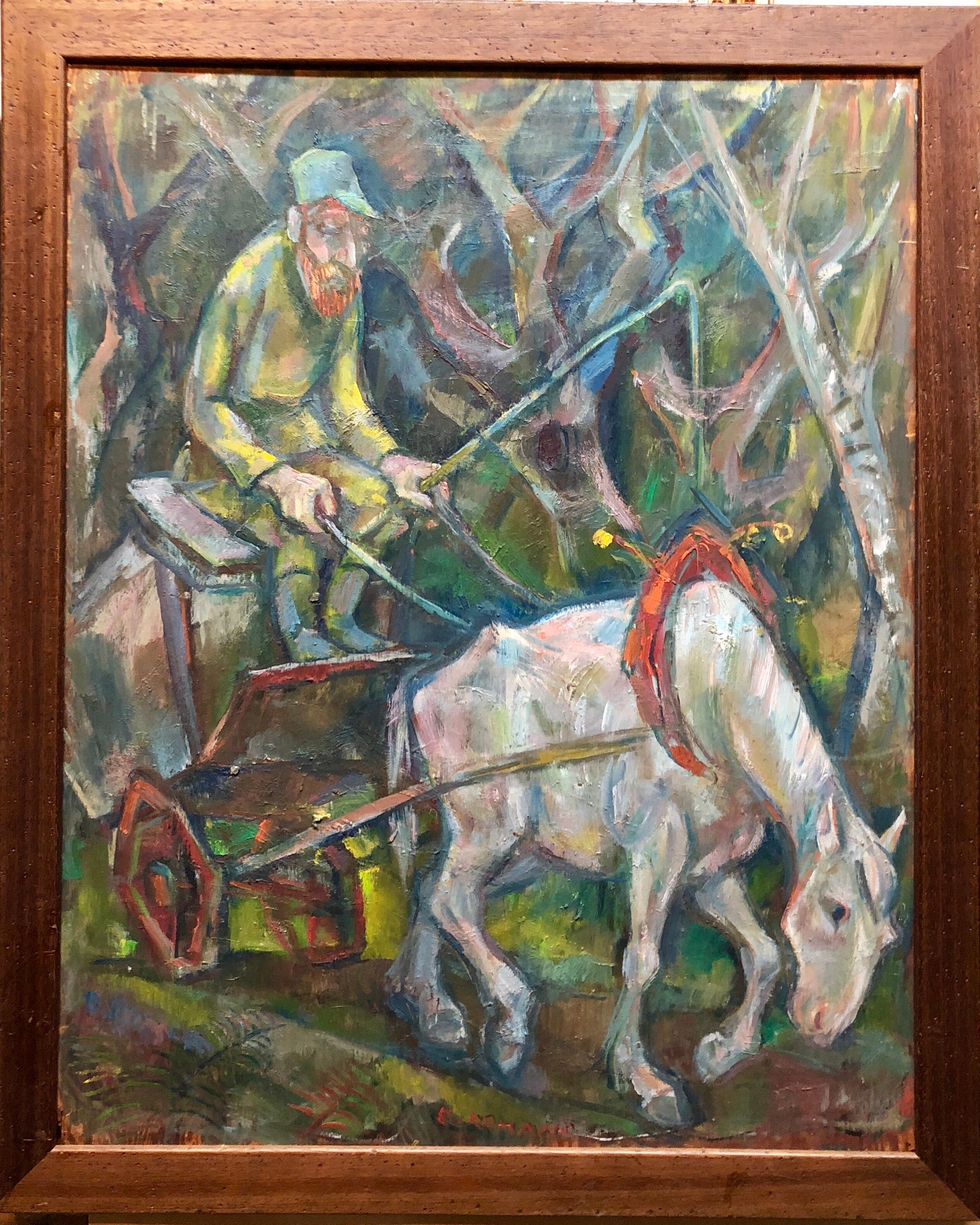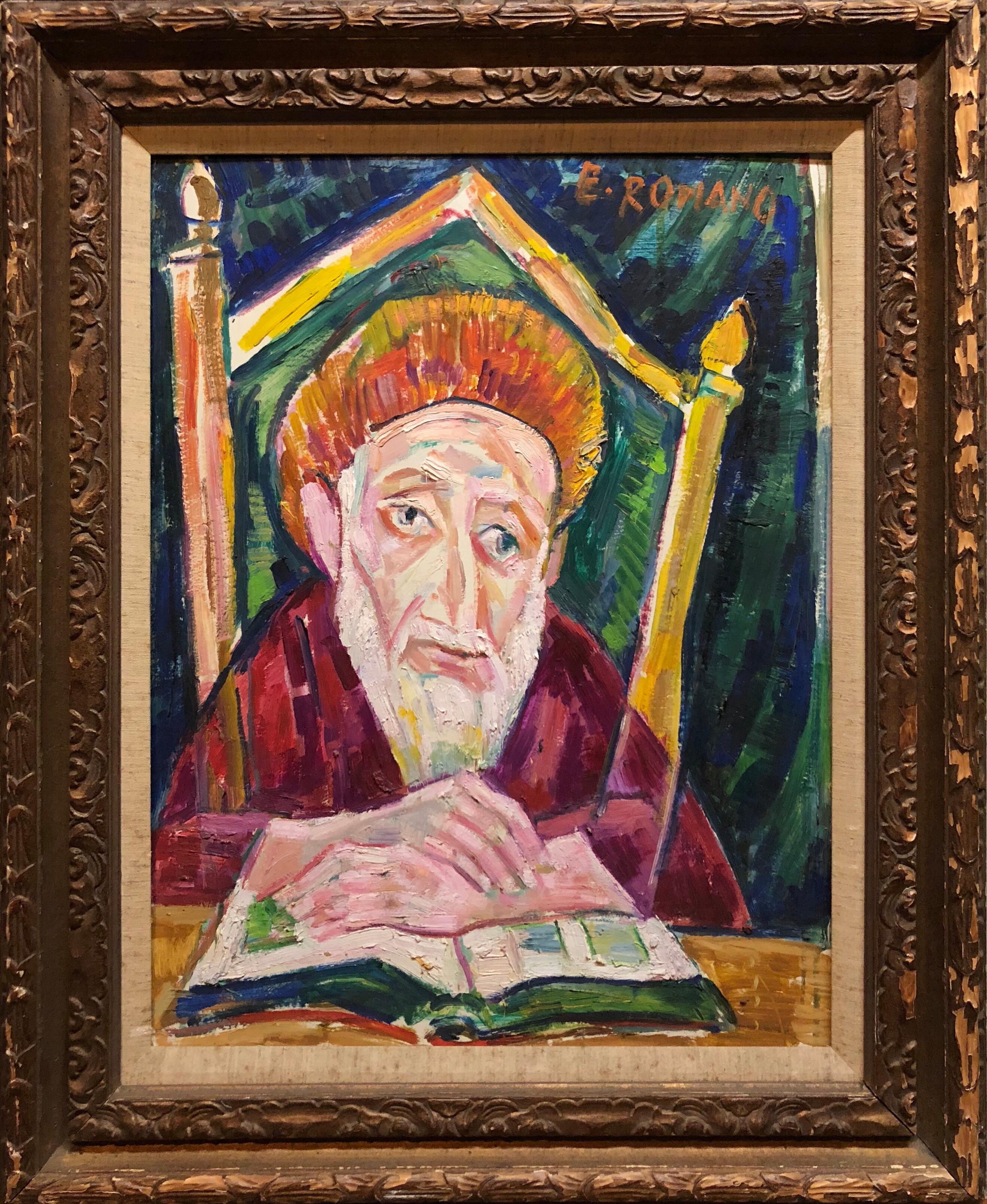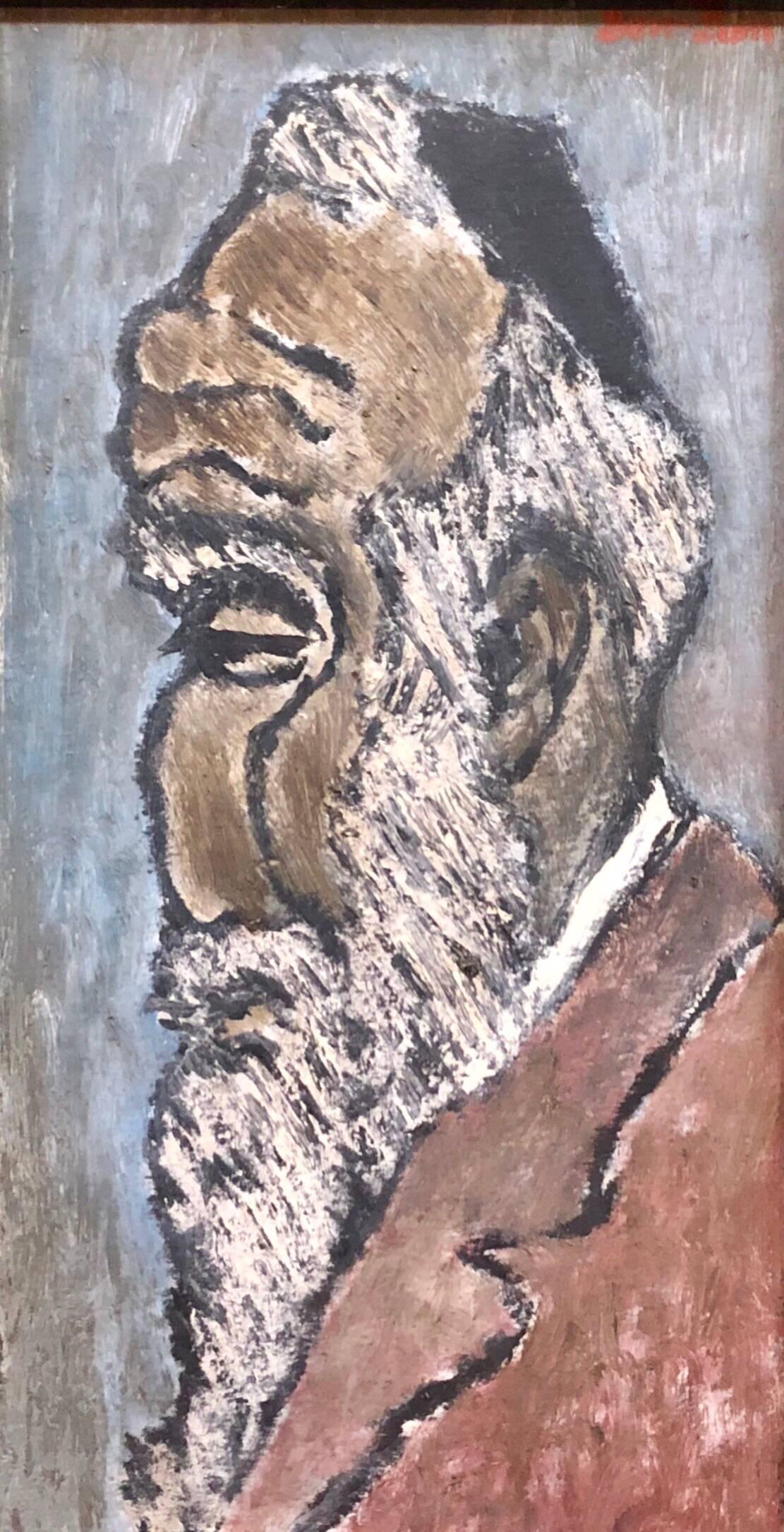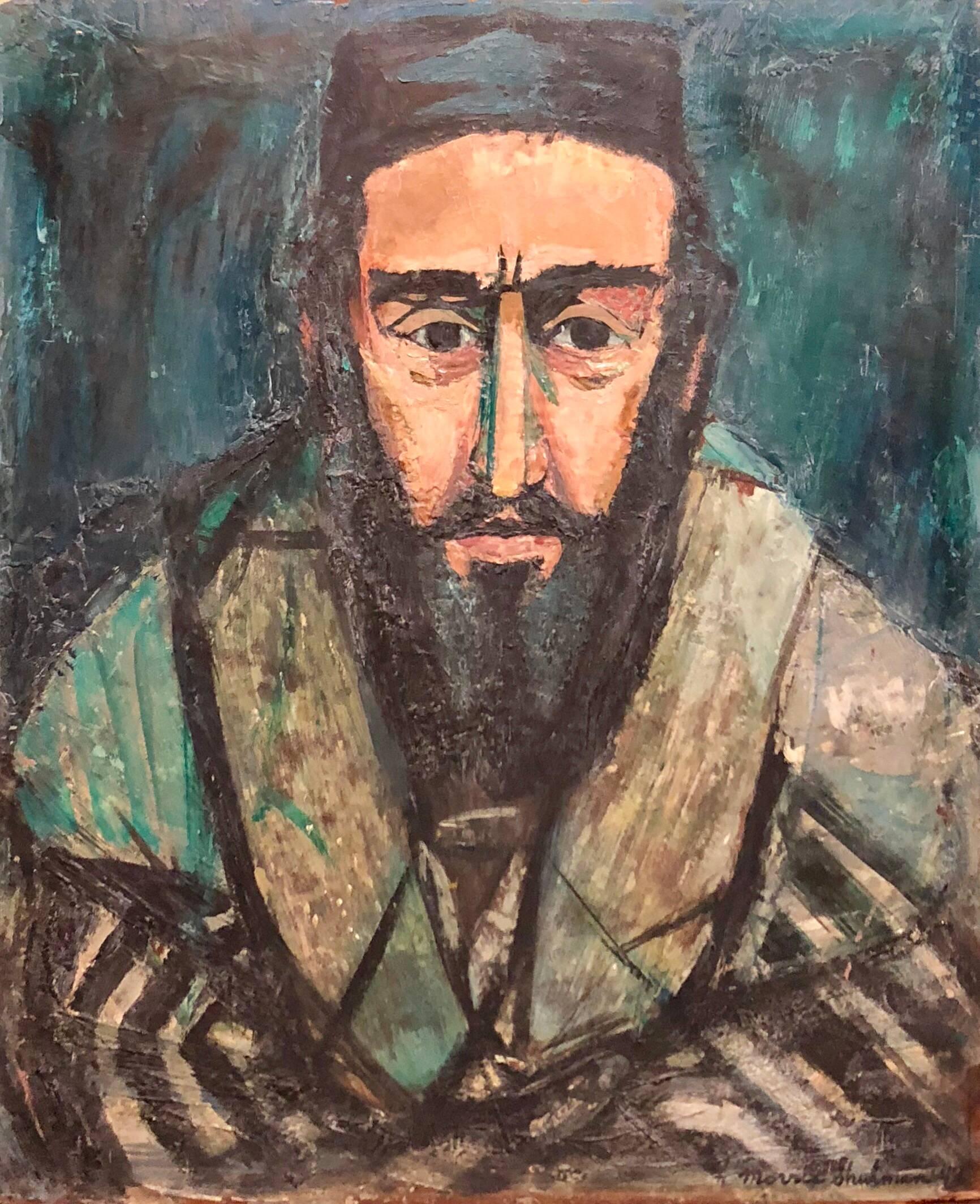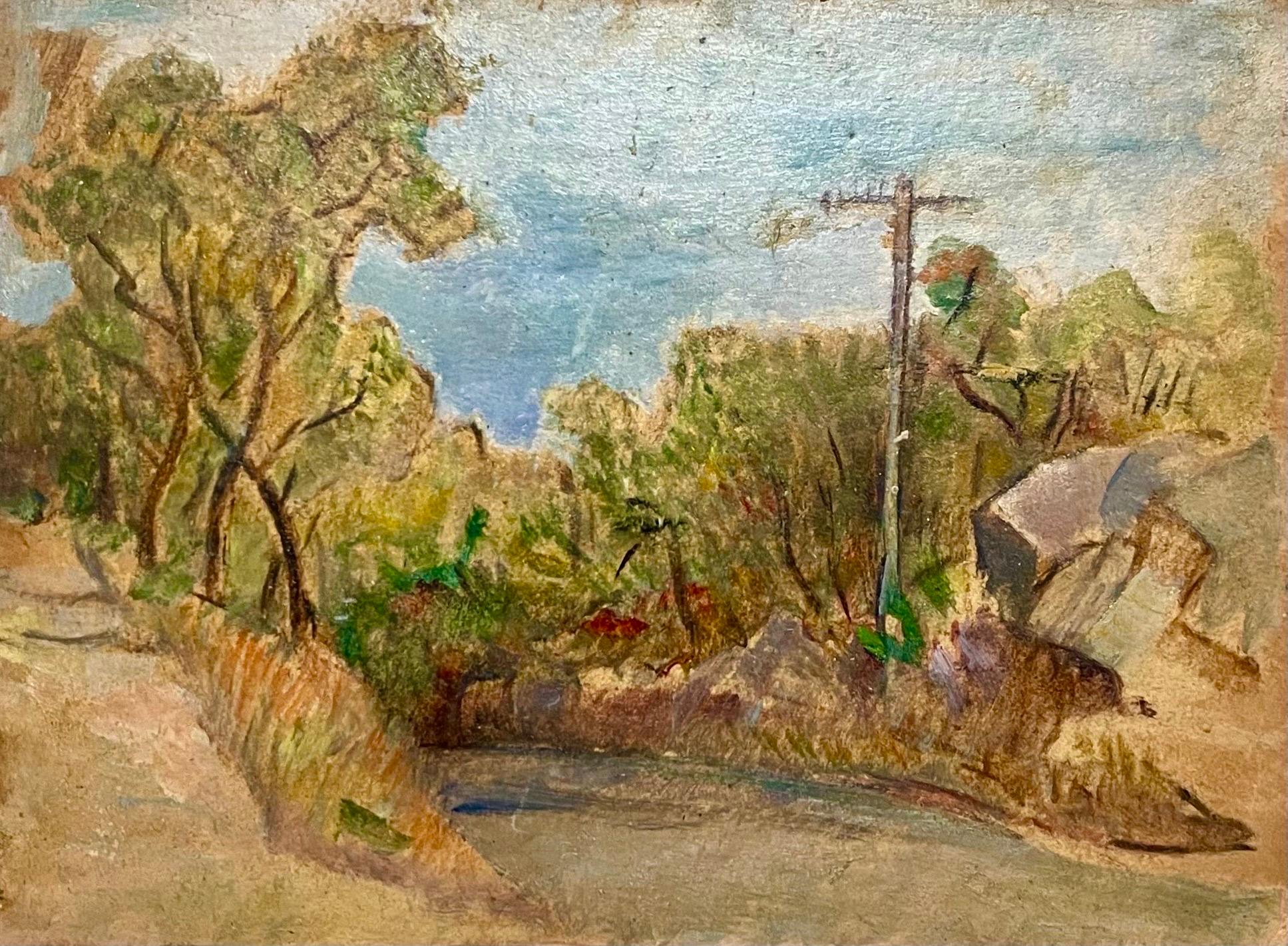Items Similar to Modern Dance Female Dancer in Red Dress Jazz - oil paint on board circa 1950s
Want more images or videos?
Request additional images or videos from the seller
1 of 9
Raimondo PuccinelliModern Dance Female Dancer in Red Dress Jazz - oil paint on board circa 1950sCirca 1950s
Circa 1950s
About the Item
Signed lower right
Raimondo (Raymond) Puccinelli (American, 1904-1986).
Puccinelli began art training at age 15 at the California School of Fine Art (now the San Francisco Art Institute) and the Schaeffer School of Design. While in Italy in 1927, he studied ancient Italian sculpture (Romanesque, Gothic, and late Renaissance) which affected his future work. After a year of studying in France and Italy with various craftsmen, he returned to San Francisco to assist in the studio of J. Vieira and study under Benny Bufano. During the decade 1930-40, he was most influenced by Mexican artist Diego Rivera. In the 1940s he maintained a studio in San Francisco's Chinatown at 15 Hotaling Place and taught sculpture at both UC Berkeley and Mills College in Oakland. He continued teaching at those schools until 1948 when he moved to Flushing, NY to teach at Queen's College. He later taught in Baltimore at the Rinehart School of Sculpture until 1960. He then moved to Florence, Italy where he remained until his death in May 1986. His work, mostly in bronze, was a link between older figurative sculptors such as Rodin and the new figuratives of the post-abstract period. He also worked in unglazed terra cotta, wood, and stone. Excerpts from his autobiographical notes: It was a veritable pleasure to know Henri Matisse whose genuinely elegant personality impressed me. He spent a short time in San Francisco on a trip, which he was making to Tahiti. After a brief meeting with me he invited himself to my studio. In a rather humorous fashion I said that I should think that he saw enough art in Paris. His reply – that he was particularly interested because I was a young sculptor and he too considered himself a sculptor (something which I did not realize) having spent eight years of work under Rodin and Bourdelle. He seemed not too pleased to be known only as a painter. The next day he was promptly at my studio. He looked carefully at all of my work – some pieces in clay were not finished and were covered over with damp cloths which he insisted on seeing also. This made me slightly embarrassed as the works were not ready for viewing. Finally he made the remark that he had been wondering. “Where are all of the men in American Art? Where are the young artists who really work and so many women in the arts and only 1/2 serious, Now I finally find one who is of the family of artists, If you were to come to Paris, you’d be one of us. Come over – and on the way stop in New York and make acquaintance with Herbert Bittner who is a lover of sculpture, - I feel that he will like your work.” Matisse talked a length about his work. He would spend a long time on a painting, turning it to the wall for many months, then taking it up again and reconsidering it. He discussed drawing. He did not feel that many critics were correct in emphasizing so very much the Near Eastern influences in his work. One point surprised me. He said that he had ardently studied and had been influenced by the drawings of Leonardo da Vinci which he said were “nature done over in a new kind of handwriting”. He spoke of finding, losing & finding again the line. – He felt that Rodin had directed him toward new paths. “You know,” he said, “that Rodin was also a colorist in his sculpture.” This discussion, parts of which come back to me from time to time, meant more to me than years of schooling. Many months later I was on my way to New York via the Indian country in the Southwest of the United States. I immediately was hard at work in a studio on 23rd Street, then moving to share a studio with a German sculptor, Carl Schmitz. It was here that Herbert Bittner came to see the work that I had been doing. Bittner, I learned, had a wide experience in the arts, especially sculpture and drawing. He had also spent some years in Rome as director of an important book store. Now director of the Westermann Gallery at Rockefeller Center, he specialized in showing works of noted European artists such as Kathe Kollwitz and Ernst Barlach, Lehmbruck, George Grosz, his emphasis being on Germans not accepted by the Hitler regime. On seeing my work, he was immediately enthusiastic and asked to exhibit my work in the gallery, that he directed. I didn’t have enough work for a one-man show (it was a large, elegant gallery), nor could I promise one in the near future as I didn’t have the capital for the castings and these works that I was doing were for bronze. Fortunately, I had worked with a Sicilian bronze caster on Long Island, Mario Scoma. He did a fine job for me and Herbert Bittner, exhibited them in a three-man show with two noted German sculptors Barlach and Lehmbruck.
- Creator:Raimondo Puccinelli (American)
- Creation Year:Circa 1950s
- Dimensions:Height: 36 in (91.44 cm)Width: 24.75 in (62.87 cm)
- Medium:
- Movement & Style:
- Period:
- Condition:
- Gallery Location:Rancho Santa Fe, CA
- Reference Number:1stDibs: LU51639780332
About the Seller
5.0
Vetted Seller
These experienced sellers undergo a comprehensive evaluation by our team of in-house experts.
Established in 1984
1stDibs seller since 2016
78 sales on 1stDibs
Typical response time: 1 hour
- ShippingRetrieving quote...Ships From: Rancho Santa Fe, CA
- Return PolicyThis item cannot be returned.
More From This SellerView All
- Abstract painting of People on the Beach oil on canvas circa 1950-1960 New YorkBy Aaron BerkmanLocated in Rancho Santa Fe, CAAaron Berkman (New York, 1900 - 1929) "Beach" Oil on canvas 20 x 24 inches Signed lower right: Aaron Berkman Unframed Provenance: Private collection, USA An abstract oil painting o...Category
Mid-20th Century American Modern Figurative Paintings
MaterialsCanvas, Oil
- The Party - oil on canvas - New York City town house at night - 20th centuryBy Aaron BerkmanLocated in Rancho Santa Fe, CAOil on canvas 30 x 24 inches Signed verso Not framed Provenance: Private collection, USA Aaron Berkman was born in Hartford, Connecticut where his parents had been settled since 1...Category
Mid-20th Century American Modern Figurative Paintings
MaterialsOil, Canvas
- People Lawn Bowling in Central Park New York City 1950 oil/canvas NYC blue greenBy Aaron BerkmanLocated in Rancho Santa Fe, CAAaron Berkman (1900 - 1991) “Bowling in Central Park” New York Oil on canvas 10 x 14 inches Signed and titled verso: Aaron Berkman 1950 Provenance: Private collection, USA Aaron Ber...Category
1950s American Modern Figurative Paintings
MaterialsCanvas, Oil
- Rowdy Mexican Cantina Brawl with Beer, Men, Guns & KnivesLocated in Rancho Santa Fe, CAOil on canvas board. FramedCategory
1950s Modern Figurative Paintings
MaterialsOil, Canvas, Board
- “Traveling Together” 2012 colorful oil/board abstract surrealist Armenian ArtistBy Vatche GeuvdjelianLocated in Rancho Santa Fe, CA“Traveling Together” is a colorful, abstract, surrealist painting by Armenian artist, Vatche Geuvdjelian painted in 2012. Artist’s Statement “𝘛𝘩�...Category
2010s Surrealist Abstract Paintings
MaterialsOil, Board
- Young Seated Woman in Pink Dress & Bouquet of Flowers yellow red blue green roseBy Luigi CorbelliniLocated in Rancho Santa Fe, CALovely painting - UnframedCategory
Mid-20th Century Modern Figurative Paintings
MaterialsOil, Canvas
You May Also Like
- Self Portrait, Oil on Board, Signed and Dated, 1925, American ModernistBy Leon KellyLocated in Doylestown, PA"Self Portrait" by Philadelphia born modernist painter Leon Kelly, is a moody and atmospheric self portrait of the artist in younger years at age 24. The 18" x 16" oil on board, fram...Category
1920s American Modern Portrait Paintings
MaterialsOil, Board
- Large Modernist Oil Painting 1940s, Judaica Hasidic Shtetl Wagon Driver WPA EraBy Emanuel Glicenstein RomanoLocated in Surfside, FLGenre: Modern Subject: Landscape with figure of horse, driver and wagon Medium: Oil Surface: wood Board EMANUEL ROMANO Rome, Italy, b. 1897, d. 1984 Emanuel Glicen Romano was born in Rome, September 23, 1897. His father Henryk Glicenstein was a sculptor and was living in Rome with his wife Helena (born Hirszenberg) when Emanuel was born. His father obtained Italian citizenship and adopted the name Enrico. Emanuel was brought up in Italy, Switzerland, Germany, England and Poland. In 1926 Emanuel Glicenstein Romano and his father sailed for New York. They briefly visited Chicago. Romano's sister, Beatrice, and mother only joined them in New York years later. Romano changed his name on his arrival to America and some have erroneously speculated that this was to avoid antisemitic discrimination. In truth, as the son of a highly-regarded artist, Romano changed his name to ensure that any success or recognition he would later attain, would be the result of nothing other than his own merit as an artist, and not on account of his father's fame. In 1936 Romano was worked for the WPA Federal Art Project creating murals. ( there were many jewish artists active with in the WPA period. notably Chaim Gross, Ben Shahn, Isaac and Moses Soyer, Abraham Rattner and many others. During and immediately after World War II, Romano created a series of allegorical works depicting graphic holocaust images that were held closely by the family until after his passing. One of these works is now on permanent display in the Florida Holocaust Museum in St. Petersburg Florida. Emanuel's father died in 1942 in a car accident before they could realize their shared dream of visiting Israel. In 1944 Romano, having completed his degree at the Pennsylvania Academy of Fine Arts and the Art Institute of Chicago, began teaching at the City College of New York. Romano moved to Safed, Israel in 1953 and established an art museum in his father's memory, the Glicenstein Museum. COLLECTIONS Indianapolis Museum of Art Metropolitan Museum of Art Boston Fine Arts Museum Fogg Museum Musée Nacional de France Recently his work has been added to the Florida Holocaust Museum collection. His notable works include his holocaust themed allegorical paintings as well as portraits of Marianne Moore, his father and William Carlos Williams...Category
1930s American Modern Figurative Paintings
MaterialsOil, Board
- Modernist Oil Painting 1940s, Judaica Hasidic Rabbi in JerusalemBy Emanuel Glicenstein RomanoLocated in Surfside, FLGenre: Portrait Subject: Landscape Medium: Oil Surface: Board Country: United States EMANUEL ROMANO Rome, Italy, b. 1897, d. 1984 Emanuel Glicenstein Romano was born in Rome, September 23, 1897. His father Henryk Glicenstein was a sculptor and was living in Rome with his wife Helena (born Hirszenberg) when Emanuel was born. His father obtained Italian citizenship and adopted the name Enrico. Emanuel was brought up in Italy, Switzerland, Germany, England and Poland. In 1926 Emanuel and his father sailed for New York. They briefly visited Chicago. Romano's sister, Beatrice, and mother only joined them in New York years later. Romano changed his name on his arrival to America and some have erroneously speculated that this was to avoid antisemitic discrimination. In truth, as the son of a highly-regarded artist, Romano changed his name to ensure that any success or recognition he would later attain, would be the result of nothing other than his own merit as an artist, and not on account of his father's fame. In 1936 Romano was worked for the Federal Art Project creating murals. During and immediately after World War II, Romano created a series of allegorical works depicting graphic holocaust images that were held closely by the family until after his passing. One of these works is now on permanent display in the Florida Holocaust Museum in St. Petersburg Florida. Emanuel's father died in 1942 in a car accident before they could realize their shared dream of visiting Israel. In 1944 Romano, having completed his degree at the Pennsylvania Academy of Fine Arts and the Art Institute of Chicago, began teaching at the City College of New York. Romano moved to Safed, Israel in 1953 and established an art museum in his father's memory, the Glicentein Museum. COLLECTIONS Indianapolis Museum of Art Metropolitan Museum of Art Boston Fine Arts Museum Fogg Museum Musée Nacional de France Recently his work has been added to the Florida Holocaust Museum collection. His notable works include his holocaust themed allegorical paintings as well as portraits of Marianne Moore, his father and William Carlos Williams...Category
1970s American Modern Figurative Paintings
MaterialsOil, Board
- Modernist Judaica Oil Painting "Old Jew" Jewish Rabbi at PrayerBy Ben-Zion WeinmanLocated in Surfside, FLAn oil on board Judaic painting by modern artist Ben-Zion Weinman. It depicts a portrait in profile of an old Jew. The work is signed "Ben-Zion". Born in 1897, Ben-Zion Weinman celebrated his European Jewish heritage in his visual works as a sculptor, painter, and printmaker. Influenced by Spinoza, Knut Hamsun, and Wladyslaw Reymont, as well as Hebrew literature, Ben-Zion wrote poetry and essays that, like his visual work, attempt to reveal the deep “connection between man and the divine, and between man and earth.” An emigrant from the Ukraine, he came to the US in 1920. He wrote fairy tales and poems in Hebrew under the name Benzion Weinman, but when he began painting he dropped his last name and hyphenated his first, saying an artist needed only one name. Ben-Zion was a founding member of “The Ten: An Independent Group” The Ten” a 1930’s avant...Category
1940s American Modern Figurative Paintings
MaterialsOil, Board
- Judaica Rabbi Portrait Oil Painting American WPA Abstract Expressionist ArtistBy Morris ShulmanLocated in Surfside, FLBorn in Savannah, Georgia in 1912, abstract expressionist painter Morris Shulman studied at the National Academy of Design, Art Students League and Hans Hofmann School of Art in New ...Category
1940s American Modern Portrait Paintings
MaterialsEncaustic, Oil, Board
- Simka Simkhovitch WPA Artist Oil Painting Gouache American Modernist PowerlineBy Simka SimkhovitchLocated in Surfside, FLSimka Simkhovitch (Russian/American 1893 - 1949) This came with a small grouping from the artist's family, some were hand signed some were not. These were studies for larger paintings. Simka Simkhovitch (Симха Файбусович Симхович) (aka Simka Faibusovich Simkhovich) (Novozybkov, Russia May 21, 1885 O.S./June 2, 1885 N.S.—Greenwich, Connecticut February 25, 1949) was a Ukrainian-Russian Jewish artist and immigrant to the United States. He painted theater scenery in his early career and then had several showings in galleries in New York City. Winning Works Progress Administration (WPA) commissions in the 1930s, he completed murals for the post offices in Jackson, Mississippi and Beaufort, North Carolina. His works are in the permanent collections of the Dallas Museum of Art, the National Museum of American Art and the Whitney Museum of American Art. Born outside Kyiv (Petrograd Ukraine) into a Jewish family who owned a small department store. During a severe case of measles when he was seven, Simcha Simchovitch sketched the views outside his window and decided to become an artist, over his father's objections. Beginning in 1905, he studied at the Grekov Odessa Art School and upon completion of his studies in 1911 received a recommendation to be admitted to the Imperial Academy of Arts. Though he enrolled to begin classes in architecture, painting, and sculpture at the Imperial Academy, he was dropped from the school roster in December because of the quota on the number of Jewish students and drafted into the army. Simchovitch served as a private in the 175th Infantry Regiment Baturyn [ru] until his demobilization in 1912. Re-enrolling in the Imperial Academy, he audited classes. Simka Simkhovitch exhibited paintings and sculptures in 1918 as part of an exhibition of Jewish artists and in 1919 placed 1st in the competition "The Great Russian Revolution" with a painting called "Russian Revolution" which was hung in the State Museum of Revolution. In 1922, Simkha Simkhovitch exhibited at the International Book Fair in Florence (Italian: Fiera Internazionale del Libro di Firenze). In 1924, Simkhovitch came to the United States to make illustrations for Soviet textbooks and decided to immigrate instead. Initially he supported himself by doing commercial art and a few portrait commissions. In 1927, he was hired to paint a screen for a scene in the play "The Command to Love" by Fritz Gottwald and Rudolph Lothar which was playing at the Longacre Theatre on Broadway. Art dealers began clamoring for the screen and Simkhovitch began a career as a screen painter for the theater. Catching the attention of the screenwriter, Ernest Pascal, he worked as an illustrator for Pascal, who then introduced him to gallery owner, Marie Sterner. Simkhovitch's works appeared at the Marie Sterner Gallery beginning with a 1927 exhibit and were repeated the following year. Simkhovitch had an exhibit in 1929 at Sterner's on circus paintings. In 1931, he held a showing of works at the Helen Hackett Gallery, in New York City and later that same year he was one of the featured artists of a special exhibit in San Francisco at the California Palace of the Legion of Honor in Lincoln Park. The exhibit was coordinated by Marie Sterner and included four watercolors, including one titled "Nudes". He is of the generation of Russian Soviet artists such as Isaac Pailes, Serge Charchoune, Marc Chagall, Chana Orloff, Isaac Ilyich Levitan, and Ossip Zadkine. In 1936, Simkhovitch was selected to complete the mural for the WPA Post office project in Jackson, Mississippi. The mural was hung in the post office and courthouse in 1938 depicted a plantation theme. Painted on the wall behind the judge’s bench, “Pursuits of Life in Mississippi”, a depiction of black workers engaged in manual labor amid scenes of white professionals and socialites, was eventually covered over in later years during renovations due to its stereotypical African American imagery. Simka painted what he thought was typical of Jackson. His impression of pre-civil rights Mississippi was evidently Greek Revival column houses, weeping willow trees, working class families, and the oppression of African Americans. He painted African American men picking cotton, while a white man took account of the harvest and a white judge advised a white family, calling it Pursuits of Life in Mississippi. Though clearly endorsed by the government and initially generally well-received, the mural soon raised concerns with locals as the climate toward racial segregation began to change. The main concern was whether depictions that show African Americans in subjugated societal roles should be featured in a courtroom. The following year, his painting "Holiday" won praise at an exhibition in Lincoln, Nebraska. In 1940, Simkhovitch's second WPA post office project was completed when four murals, "The Cape Lookout Lighthouse and the Orville W. Mail Boat", "The Wreck of the Crissie Wright", "Sand Ponies" and "Canada Geese" were installed in Beaufort, North Carolina. The works were commissioned in 1938 and did not generate the controversy that the Jackson mural had. The main mural is "The Wreck of the Crissie Wright" and depicts a shipwreck which had occurred in Beaufort in 1866. "The Cape Lookout Lighthouse and the Orville W. Mail Boat" depicted the lighthouse built in 1859 and the mail boat that was running mail during the time which Simkhovitch was there. The boat ran mail for the area until 1957. "Sand Ponies" shows the wild horses common to the North Carolina barrier islands and "Canada Geese" showed the importance of hunting and fishing in the area. All four murals were restored in the 1990s by Elisabeth Speight, daughter of two other WPA muralists, Francis Speight...Category
1930s American Modern Landscape Paintings
MaterialsGouache, Oil, Board

